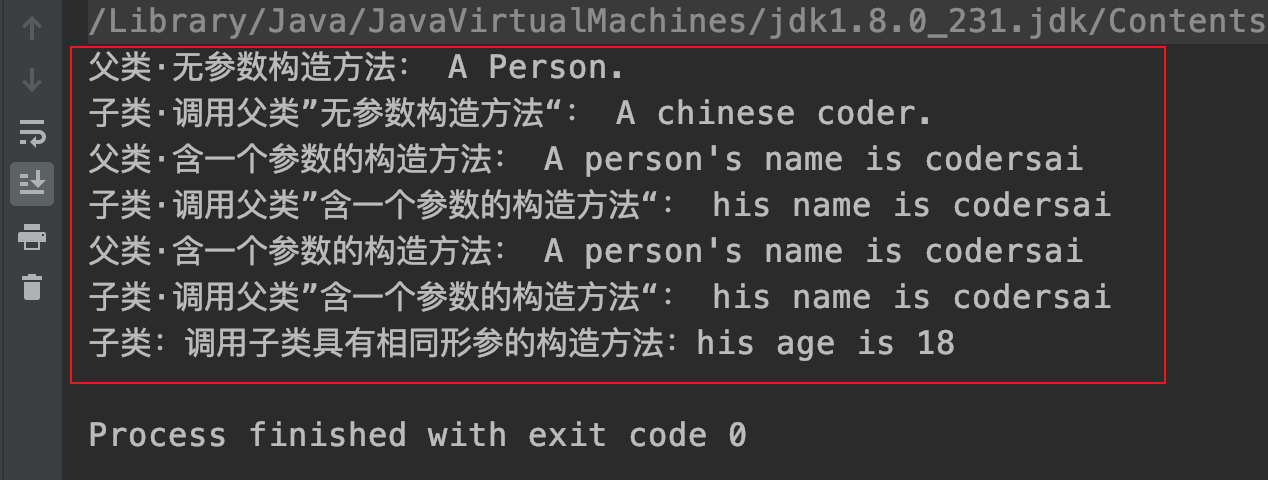当前对象与父对象(this\super)
阅读 (200028)
分享
1、this
1.1、this概述
this是自身的一个对象,代表对象本身,是非静态对象,可以理解为:指向对象本身的一个指针。
public class ThisDemo {
public static void main(String[] args) {
//this.print();//this是非静态对象
new ThisDemo().view();
}
public void view() {
this.print();
}
public void print() {
System.out.println("ThisDemo");
}
}
运行结果:

1.2、this应用
1.2.1、直接引用
this相当于是指向当前对象本身。
public class ThisDemo01 {
String s = "Hello";
public ThisDemo01(String s1) {
System.out.println("s = " + s1);
//this当前对象,调用s属性
System.out.println("1 -> this.s = " + this.s);
this.s = s1;//把参数值赋给成员变量,成员变量的值改变
System.out.println("2 -> this.s = " + this.s);
}
public static void main(String[] args) {
ThisDemo01 x = new ThisDemo01("HelloWorld!");
System.out.println("s=" + x.s);//验证成员变量值的改变
}
}
运行结果:

1.2.2、形参与成员变量名字重名,用this来区分
class Person {
private int age = 10;
public Person() {
System.out.println("初始化年龄:" + age);
}
public int GetAge(int age) {
this.age = age;
return this.age;
}
}
public class ThisDemo02 {
public static void main(String[] args) {
Person Harry = new Person();
System.out.println("Harry's age is " + Harry.GetAge(12));
}
}
运行结果:

1.2.3、引用构造函数
这个我们用super一起讲。
1.2.4、同时传递多个参数
public class ThisDemo03 {
int x;
int y;
static void showtest(ThisDemo03 tc) {//实例化对象
System.out.println(tc.x + " " + tc.y);
}
void seeit() {
showtest(this);
}
public static void main(String[] args) {
ThisDemo03 p = new ThisDemo03();
p.x = 9;
p.y = 10;
p.seeit();
}
}
运行结果:

2、super
2.1、super概述
super可以理解为是指向自己超(父)类对象的一个指针,而这个超类指的是离自己最近的一个父类。
2.2、super应用
2.2.1、直接引用
与this类似,super相当于是指向当前对象的父类,这样就可以用super.xxx来引用父类的成员。
class A{
public void print(){
System.out.println("A");
}
}
public class SuperDemo01 extends A{
public static void main(String[] args) {
//super.print();//super是非静态对象
new SuperDemo01().view();
}
public void view(){
super.print();
}
}
运行结果:

2.2.2、子类成员重写父类成员后
子类中的成员变量或方法与父类中的成员变量或方法同名
class Country {
String name;
void value() {
name = "China";
}
}
public class City extends Country {
String name;
void value() {
name = "Shanghai";
super.value(); //调用父类的方法
System.out.println(name);
System.out.println(super.name);
}
public static void main(String[] args) {
City c=new City();
c.value();
}
}
运行结果:

2.2.3、引用构造函数
super(参数):调用父类中的某一个构造函数(应该为构造函数中的第一条语句)。
this(参数):调用本类中另一种形式的构造函数(应该为构造函数中的第一条语句)。
package cn.com.tyschool.demo001;
class Persones{
public void prt(String s) {
System.out.println(s);
}
//构造方法(1)
public Persones() {
prt("父类·无参数构造方法: "+"A Person.");
}
//构造方法(2)
public Persones(String name) {
prt("父类·含一个参数的构造方法: "+"A person's name is " + name);
}
}
public class Chinese extends Persones {
Chinese() {
super(); // 调用父类构造方法(1)
prt("子类·调用父类”无参数构造方法“: "+"A chinese coder.");
}
Chinese(String name) {
super(name);// 调用父类具有相同形参的构造方法(2)
prt("子类·调用父类”含一个参数的构造方法“: "+"his name is " + name);
}
Chinese(String name, int age) {
this(name);// 调用具有相同形参的构造方法(3)
prt("子类:调用子类具有相同形参的构造方法:his age is " + age);
}
public static void main(String[] args) {
Chinese cn = new Chinese();
cn = new Chinese("codersai");
cn = new Chinese("codersai", 18);
}
}
运行结果:

3、this/super区别
3.1、super()/this()
super(参数):调用父类中的某一个构造函数(应该为构造函数中的第一条语句)
this(参数):调用本类中另一种形成的构造函数(应该为构造函数中的第一条语句)
class A{
public A(){
System.out.println("无参");
}
public A(int x){
System.out.println("参数为:"+x);
}
}
class B extends A{
public B(){
//super();
super(12);
}
public static void main(String args[]){
new B();
}
}
class B{
public B(){
this(12);
}
public B(int x){
System.out.println("参数为:"+x);
}
public static void main(String args[]){
new B();
}
}
3.2、super/this
super: 它引用当前对象的直接父类中的成员(用来访问直接父类中被隐藏的父类中成员数据或函数),基类与派生类中有相同成员定义时如:
super.成员(成员变量、成员方法)
this:它代表当前对象名(在程序中易产生不同意义,应使用this来指明当前对象;如果函数的形参与类中的成员数据同名,这时需用this来指明成员变量名)
class A{
public void a(){
System.out.println("a");
}
}
class B extends A{
public static void main(String args[]){
B b=new B();
b.b();
}
public void a(){
System.out.println("b");
}
public void b(){
super.a();
}
}
class B{
int x=12;
public static void main(String args[]){
new B().b(13);
}
public void b(int x){
System.out.println(x);
System.out.println(this.x);
}
}
3.3、super/this为非静态成员
class B{
public static void main(String args[]){
//super.成员//不能在静态方法里面使用
}
}
class B{
public static void main(String args[]){
//this.成员//不能在静态方法里面使用
}
}
需要
登录
才可以提问哦
:

